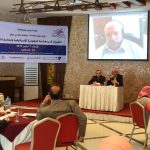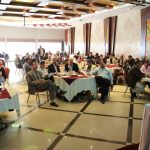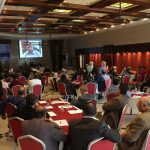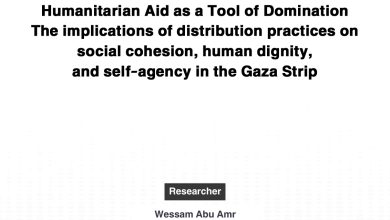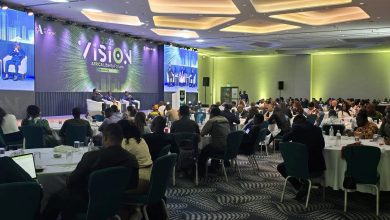“The Israeli-Jewish demographic changes and their political dimensions;” by the researcher, Barhoum Jaraisi
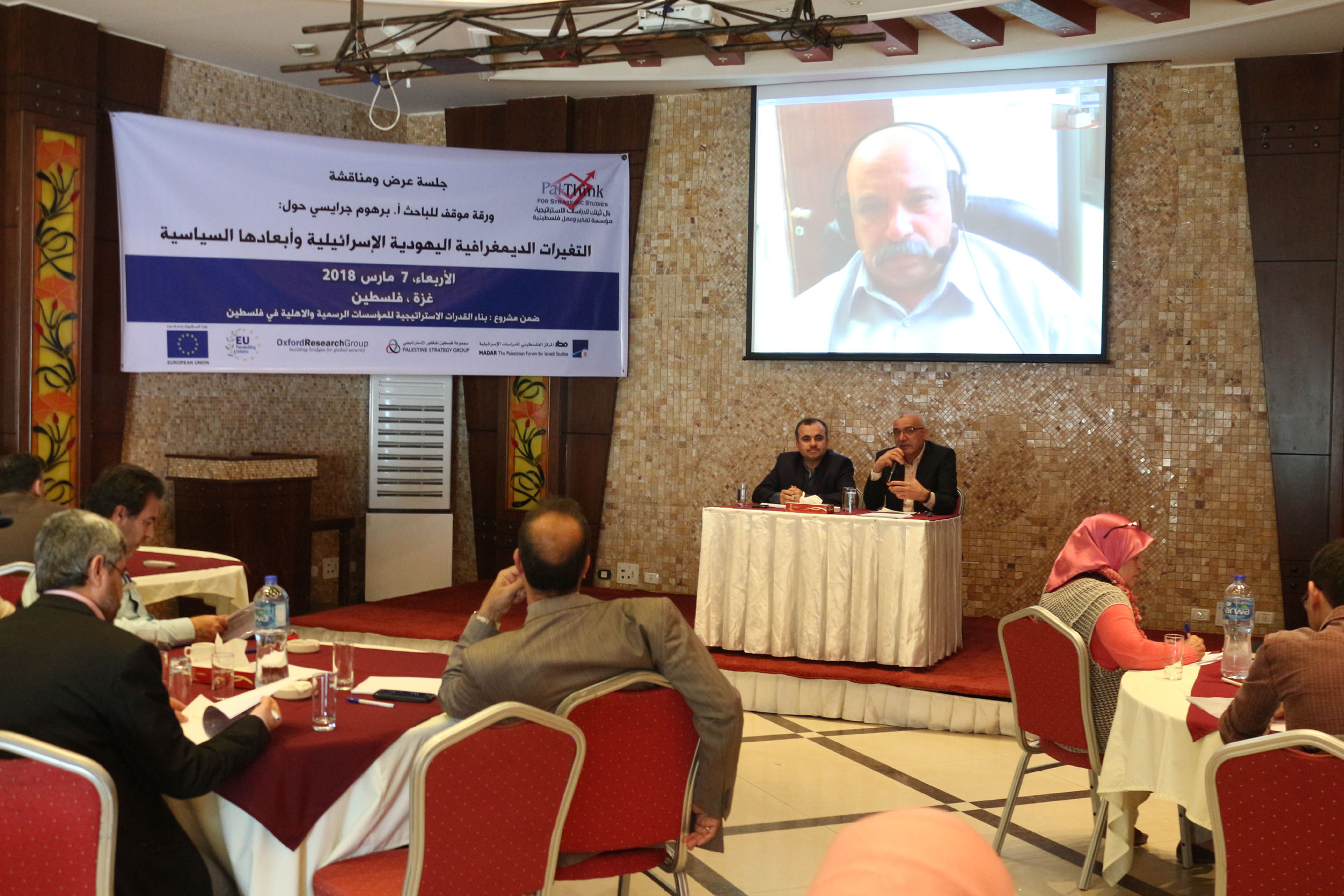
Date: Wednesday, March 7, 2018, 12:30 p.m.
Location: Lighthouse Restaurant, Gaza city, Palestine.
Background:
“Building Strategic Capacity: Empowering Civil, Political and Emerging Constituencies in Palestine and Israel” is an EU Peacebuilding Initiative-funded project that develops the ongoing work of the Palestine Strategy Group (PSG), the Palestinian Citizens of Israel Group (PCIG) and the Israeli Strategic Forum (ISF). This roundtable discussion was part of the PSG dimension of the project. Since being founded in 2008, the PSG has produced a considerable number of studies and strategic reports on the Palestinian issue. In cooperation with Pal-Think for Strategic Studies, the Palestinian Center for Israeli Studies (MADAR) and Oxford Research Group, the PSG will produce 12 research papers between 2017 and 2020 which deal with multiple themes and perspectives that then culminates in the publication of the Strategic Policy Manual “Palestine 2020”. This policy report will be presented at a major conference in Ramallah in 2020 and incorporate all the findings of the 12 PSG research papers as well as findings of the PCIG.
Workshop’s Attendees:
The workshop was conducted in the Gaza strip. Attendees included Mr. Omar Sha’aban, head of Pal-Think for Strategic Studies; Mr. Barhoum Jaraisi, a Palestinian journalist and political writer specialized in the Israeli political map and a researcher for the Palestinian Forum for Israeli Studies (MADAR); Dr. Adnan Abu Amer, researcher and university professor of political science from the Gaza strip. The session was attended by 78 participants, 16 of them were females, 27 were under the age of 30 years old. This includes people from different backgrounds such as journalists, writers, analysts and college students. Several participants have posted their positive and constructive feedback about the session, the content, the discussion, and Palthink’s work on their Facebook pages.
Omar Sha’aban’s Contribution:
Mr. Omar Sha’aban began the session, welcomed all the attendees and noted that Pal-Think-based on its mission and continuous activities—is consistently working on what serves the Palestinian issue and enrich their thinking and understanding, to help them toward building an effective Palestinian strategy. In addition to, he referred to the research paper as a great work which tackles a new important topic. He also introduced the researcher Mr. Barhoum Jaraisi, Dr. Adnan Abu Amer and informed the attendees about the Oxford research group and its mission along with the project “Building Strategic Capacity: Empowering Civil, Political and Emerging Constituencies in Palestine and Israel.”
Mr. Barhoum Jaraisi’s Contribution:
Mr. Jaraisi summarized his research paper in twenty minutes. He said that the paper tries to investigate the demographic evolution of Israelis and Jews in Israel and how this demographic change plays a role in formulating the internal Israeli politics. Until the 1980s, the Israeli government and Zionism have been very concerned about the demographic factor, due to the fact that the Palestinians who stayed in Palestine after the 1948 Palestinian exodus, also known as the Nakba had a higher Birth rate than the Jews in Israel. This urged Israel to attract thousands of Jewish migrants from Arab and Islamic countries to rein the growing the Arab-Israeli population there and have a Jewish majority over the Arabs in Israel. This demographic worry was caused by other two factors; first, the downward trend in the number of Jews in the world standing at 14 million, about 6.5 million live in Israel, that happened because of the low Birth rate 1.3, and also due to the Interfaith marriages. For example, in 1985 about 25% of the born Jews in Israel belonged to mixed families, and second the intra-Israeli demographic fluctuations.
From 1989-2000s the number of Sephardi Jews was 43-47% out of the total Jews in Israel, whereas the Ashkenazi Jews were just 40%, and the rest is from those who were born in Israel. Back then, the Sephardi Jews have gone through a wave of racism and discrimination from the Ashkenazi Jews, just because of their ethnicity. For Zionism it was important to have a demographic majority over the 153,000 Palestinians who stayed in their lands, who represent 13% of the lands which Israel started its entity on. Therefore, the only way to achieve that goal was attracting the Ashkenazi Jews to migrate to their country “Israel”. Due to the fact, that Sephardi Jews had bad social and economic situation, being classified as the poor and nonproductive class with no higher positions within the country such as Prime minister position. However, in the 1970s a new generation of Youth Jews rejected the discrimination between Sephardi Jews and Ashkenazi Jews in all forms of living, they succeeded to influence the political parties in Israel, that’s when the Likud-National Liberal Movement started to rule the country until 1979.
Since then, the social and economic status for the Sephardi Jews is consistently improving to the better, while the separation based on each one’s ethnicity has nearly gone away. For instance, taking salaries as an index for the standard of living, it is a constant 67% and 131% for Arab citizens of Israel and Ashkenazi Jews respectively. While the only class which got improved throughout the years, was the Sephardi Jews moved from 100 to reach 114% increase in their salaries, so they are never poor again. However, the ones who are poor and represent an economic burden on Israel, because they are consumers rather than producers, are the ultra-Orthodox Jews or the Haredim who have a high Birth rate 3.8% and represent 13% out of the population of Israel.
Dr. Adnan Abu Amer’s Contribution:
Dr. Abu Amer noted the importance of this research paper and further improvement it can be an invaluable reference for students and professors. He noted that regarding the Palestinians who stayed in Palestine after the 1948 Palestinian exodus, saying Israel was forced to let them stay, it was not voluntarily done. If Israel had the power, it could have kicked them out, to ensure a whole country completely for Jews. Dr. Abu Amer criticized using the term “Mixed marriage” between Jews from the same ethnicity. Though this reflects a fragility within the Israeli society and triggers the question: Is there a real harmony between Jews within Israel. He also mentioned the role of some Sephardi Jews in leading Israel and their decisions against the Arab as a sign for showing their loyalty to the Ashkenazi Jews. He further emphasized that these days the Arab-citizens of Israel have a lower birth rate than before and there is a harsh extremism “Similar to Taliban or ISIS” being practiced in Israel by the ultra-Orthodox Jews. Israel works very hard convincing the ultra-Orthodox Jews to settle in Jerusalem to have a Jewish majority over Arabs there. Finally, he noted that the Israeli crisis and problems do not indicate to the end of Israel next month or even the next couple of years.
Attendees’ questions:
Attendees stated that the research paper is invaluable and noted that they are thankful for Pal-Think for strategic studies and Mr. Jaraisi for his efforts. The following questions have been asked:
- Did the mixed or interfaith marriage succeed in erasing the separation between Sephardi Jews and Ashkenazi Jews?
- What are the repercussions of the demographic changes in the Israeli society and its impact on the peacebuilding process?
- What are the main reasons of the birth rate drop for the Arab citizens of Israel?
- Why are the secular Jews afraid of the growing population of ultra-Orthodox Jews?
- What is the driver for the demographic conflict in Israel, is it internal or external?
- Do the ethnic and religious variances reflect a nearly coming end for Israel?
- What is the impact of the unstable security situation in the West back on the demographic factor?
- Are these demographic changes going to lead to a Sephardic Prime minister for the first time?
Mr. Jaraisi’s Answers:
He emphasized that the demographic crisis and other societal problems in Israel do not directly lead to the collapse of Israel, but as time goes on, the accumulated crisis might cause so. In addition, he stated that until the 1990s the ultra-Orthodox Jews were completely out of the political table, they have never intervened, but now they are keeping up with the secular Israeli government as it satisfies their needs for example, the government provides them with offers to live comfortably in settlements as their own specialized and closed world. Recently, the secular Israeli government is trying to recruit the ultra-Orthodox youths, who do not participate in the army for some religious reasons. This is not because the government needs them, but to break the ice that hinders the relation between; the secular Israelis and the ultra-Orthodox Jews.

